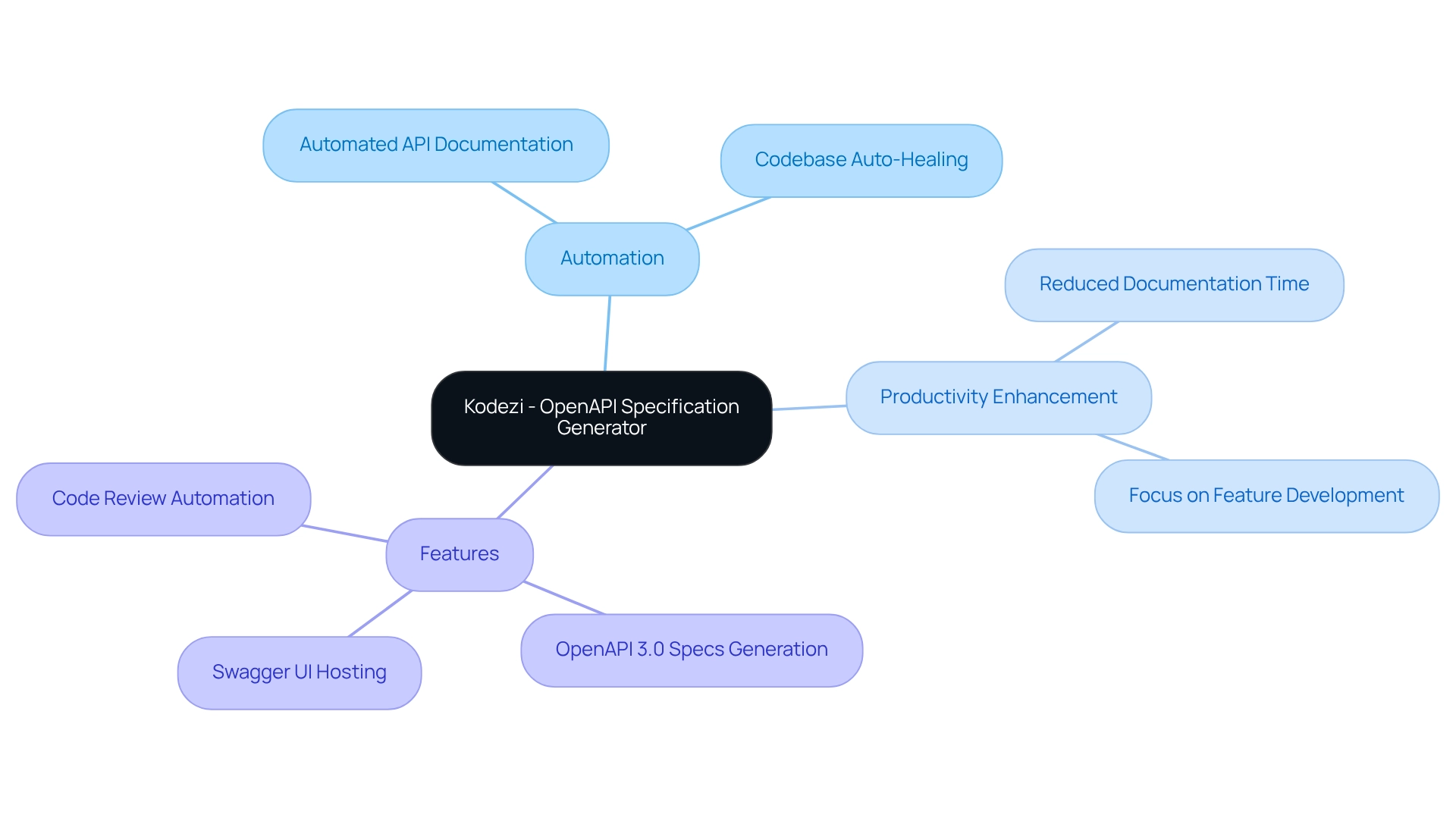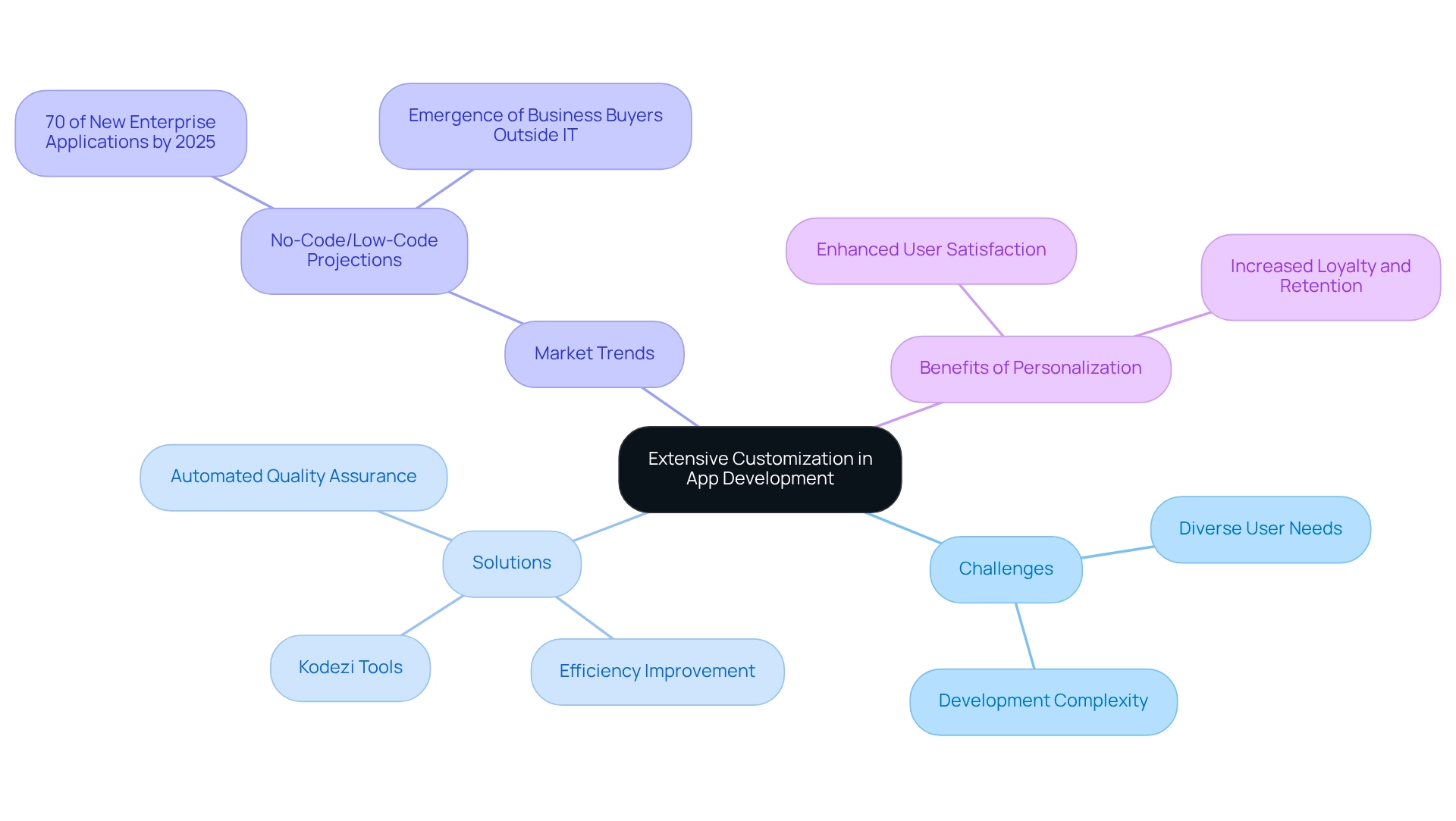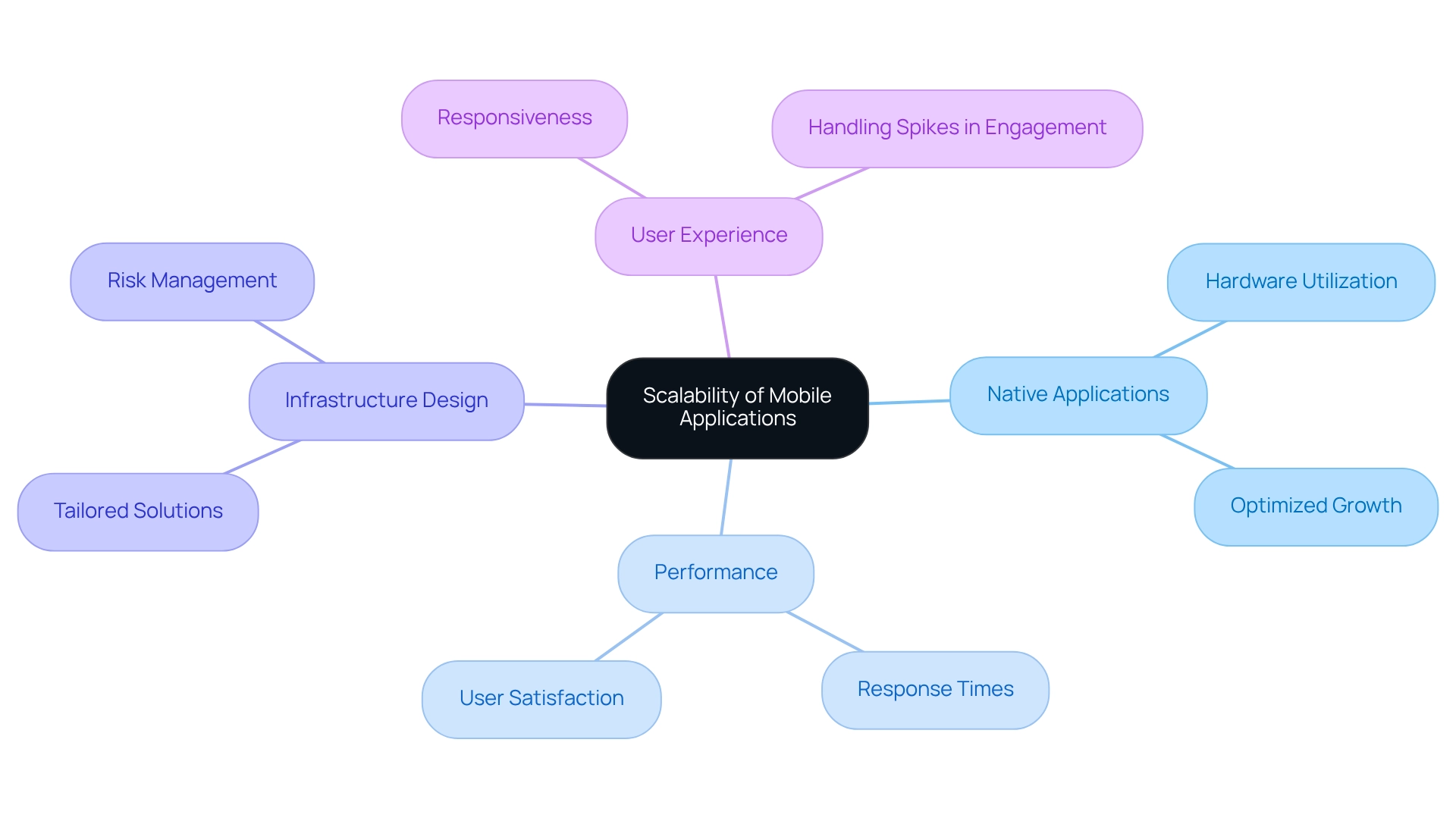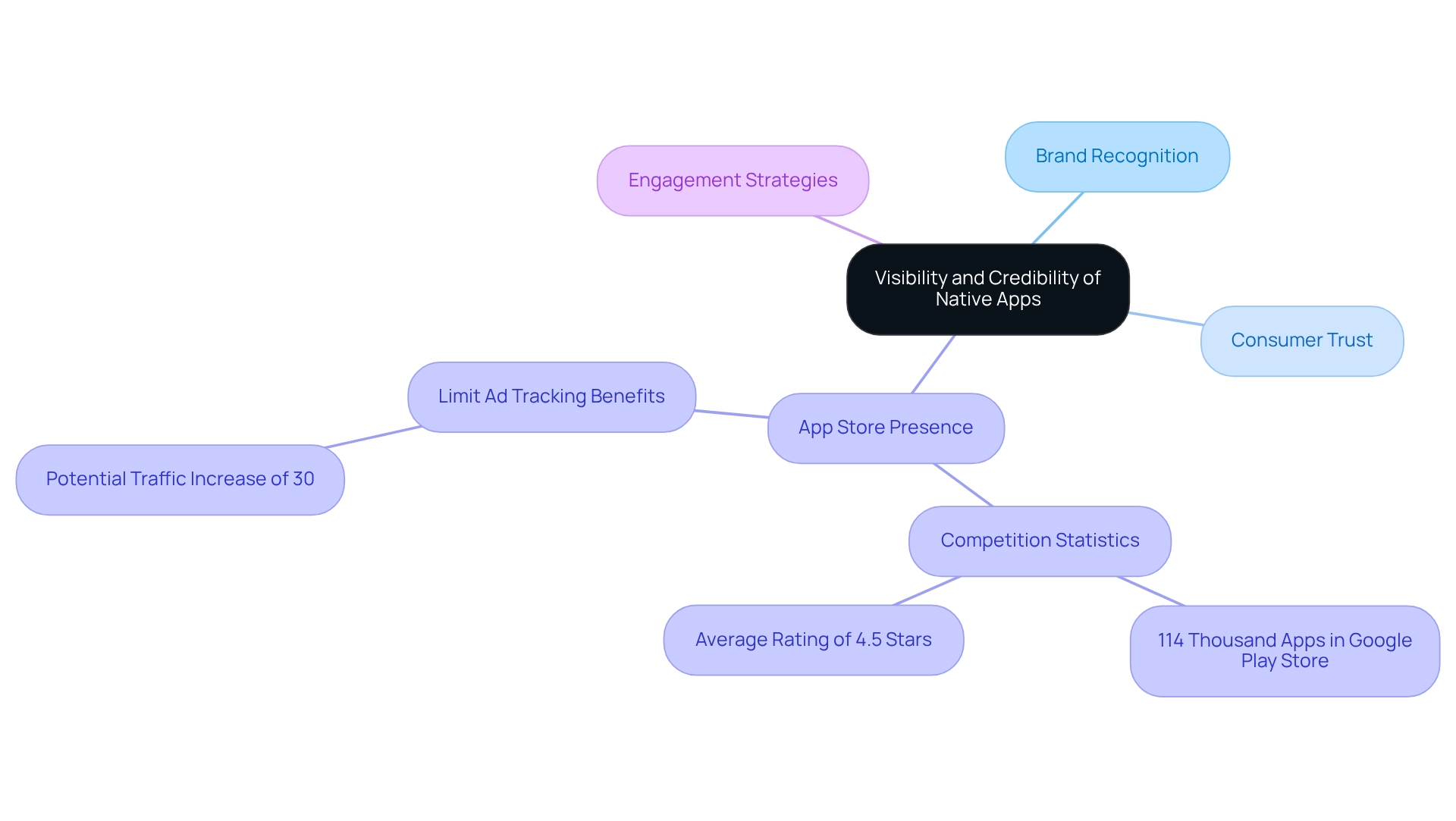Overview
In the world of mobile application development, developers often face significant challenges when choosing the right approach. One compelling solution is native mobile application development, which offers distinct advantages over alternative options. Native apps deliver superior performance, enhanced user experience, and robust security. These factors not only justify their higher initial costs but also lead to better long-term returns for businesses.
Furthermore, the benefits of native apps extend beyond mere performance; they significantly improve user satisfaction and engagement. By providing a seamless experience tailored to the platform, businesses can foster loyalty and drive growth.
In addition, investing in native development can streamline updates and maintenance, ultimately saving resources in the long run. By choosing native, companies can ensure their applications remain competitive and secure in an ever-evolving digital landscape.
If you're considering the best approach for your next mobile project, explore the advantages of native mobile application development. The long-term benefits can outweigh the initial investment, making it a wise choice for businesses aiming for success.
Introduction
In the ever-evolving realm of mobile app development, developers often encounter significant challenges that can hinder their projects. How can they ensure the performance, security, and user satisfaction necessary for success? Native apps have emerged as frontrunners, offering unparalleled advantages over hybrid and web alternatives. By harnessing device-specific capabilities, these applications deliver superior speed and responsiveness, ensuring robust security and a flawless user experience.
Furthermore, tools like Kodezi are designed to enhance the development process, addressing these coding challenges head-on. With features that streamline workflows and optimize coding practices, Kodezi empowers developers to harness their creativity without the usual frustrations. In addition, the potential for customization and scalability becomes limitless, allowing businesses to adapt and grow in a competitive landscape.
The myriad benefits of native app development underscore its position as the optimal choice for businesses aiming to thrive. By utilizing Kodezi, developers can improve productivity and code quality, ultimately leading to a more successful application. Are you ready to explore the tools available on the Kodezi platform and elevate your development experience?
Kodezi | Professional OpenAPI Specification Generator - AI Dev-Tool: Streamline Your Mobile App Development Process
In the fast-paced world of software development, coding challenges can often hinder progress. Kodezi addresses these challenges with its powerful OpenAPI specification generator, which automates API documentation and simplifies the integration of backend services into mobile software. By leveraging Kodezi, developers can produce well-documented and standardized APIs, essential for maintaining high-quality code in mobile application native development. This automation not only accelerates the documentation process but also minimizes errors during integration, allowing developers to focus on creating robust applications.
Furthermore, with Kodezi CLI, teams can auto-heal codebases in seconds, eliminating the time-consuming process of pull requests. This Swiss-Army Knife for programmers enhances productivity by automating code reviews and ensuring API documentation remains in sync with code changes. Did you know that automated API documentation can reduce the time spent on documentation by up to 50%? This statistic highlights how Kodezi enables developers to dedicate more time to building features rather than writing documentation.
In addition, Kodezi facilitates the automatic generation of OpenAPI 3.0 specs from your codebase and hosts Swagger UI sites for API testing, making collaboration with team members seamless. This underscores the importance of robust documentation tools in the ever-evolving landscape of mobile application native development, especially considering the updated App Store Review Guidelines and Developer Agreements that highlight the necessity for clear and structured documentation.
As noted by Daniele Procida, software documentation can be categorized into learning-oriented tutorials, goal-oriented how-to guides, understanding-oriented discussions, and information-oriented reference material. With the increasing demand for efficient API documentation, Kodezi emerges as a vital tool that not only enhances developer productivity but also streamlines the workflow for mobile application native development. Explore the tools available on the Kodezi platform to elevate your coding experience.

Enhanced Performance: Achieve Superior Speed and Responsiveness with Native Apps
Mobile application native programs are specifically developed for the operating system they run on, enabling them to utilize device hardware and software more efficiently. This optimization results in quicker load times, smoother animations, and an overall enhanced responsiveness compared to mobile application native or hybrid programs.
For instance, built-in software can directly access device features such as the camera and GPS, significantly improving user experience and functionality. Furthermore, this direct access enables developers to create mobile application native solutions that feel more integrated and responsive, addressing common pain points faced in coding.
Robust Security: Leverage Advanced Security Features in Native Mobile Applications
Native mobile software leverages the built-in security capabilities of their platforms, including biometric authentication and secure data storage, to safeguard individual information from unauthorized access and breaches. A significant portion of built-in applications now employs biometric authentication, which enhances user verification methods and diminishes the risk of identity theft. Furthermore, these applications can implement platform-specific security protocols, substantially reducing their vulnerability to common threats often targeting hybrid and web software.
In 2025, the mobile software security landscape has evolved, with native programs integrating enhanced features like Runtime Software Self-Protection (RASP). This technology operates in real-time to detect and prevent various attacks, providing an additional layer of security without compromising system performance. RASP effectively identifies both known and emerging threats by analyzing user behavior and software logic, making it an essential component of modern mobile security strategies. This is particularly notable given that 43% of spoofing attacks mimicked Microsoft, highlighting the critical need for robust security measures.
Data on security breaches in mobile software indicates that certain types of attacks, such as phishing, have surged, with a reported 51% increase in phishing attacks hosted at subdomain providers. This underscores the importance of strong security measures in mobile applications, as the consequences of breaches can be severe; for example, an attacker claimed to have accessed 7 million distinct Social Security numbers. Expert assessments stress that incorporating sophisticated security features not only protects data but also enhances trust and engagement, making mobile application native programs a preferred choice for developers focused on security. As the mobile software environment continues to evolve, the emphasis on security remains paramount. Events like Spotify's $5.4 million penalty for GDPR breaches in 2023 serve as a cautionary tale, urging developers to prioritize the integration of comprehensive security features in their native software to mitigate risks and effectively protect personal information.
Flawless User Experience: Deliver Intuitive and Engaging Interfaces with Native Apps
In today's competitive app landscape, providing a flawless experience for users is essential. Mobile application native designs are meticulously created to adhere to the specific guidelines and standards of their respective platforms, resulting in interfaces that are both intuitive and recognizable. This commitment to established design principles fosters a seamless experience, significantly enhancing user satisfaction and retention rates. For instance, software developed for specific platforms employs unique gestures and animations, which not only enhance visual appeal but also promote user engagement.
Statistics reveal that these applications boast higher retention rates compared to hybrid alternatives, primarily due to their optimized performance and responsiveness. Indeed, user experience ratings for mobile application native solutions often surpass those of hybrid applications, underscoring the advantages of native development. A notable example is Headspace, a meditation and mindfulness application that exemplifies effective experience design. Its visually appealing interface and guided sessions create a calming atmosphere, assisting users in stress relief and focus enhancement. This illustrates how thoughtfully designed mobile applications can positively impact mental well-being.
Expert insights emphasize the crucial role of usability testing in mobile app development. As Vladimir Terekhov highlights, usability testing identifies areas for improvement, enabling developers to create applications that meet high usability standards. Moreover, the trend of minimalistic design continues to shape mobile interactions, prioritizing clarity and ease of navigation. By focusing on these design principles, a mobile application native can significantly enhance engagement and satisfaction, ultimately leading to a more successful product.
Extensive Customization: Tailor Your App to Meet Unique User Demands
Native app development presents significant challenges for developers, particularly in customization. How can developers effectively meet the diverse needs of their target audience? Kodezi offers a solution by providing tools that streamline the customization process, allowing developers to focus on creating tailored experiences. With extensive customization options, developers can craft features that resonate with users, incorporating distinctive branding elements and specialized functionalities.
This adaptability is crucial for businesses striving to differentiate themselves in a competitive landscape. As the trend towards no-code and low-code platforms expands, it is projected that by 2025, these platforms will account for 70% of new enterprise software. This statistic underscores the increasing demand for user-centric solutions. For example, case studies reveal that customized features, such as revamped tab bars converting into sidebars, significantly enhance navigation and user satisfaction. Furthermore, expert insights consistently indicate that personalization in mobile application native development not only meets unique consumer needs but also fosters loyalty and retention. This makes it a vital component of successful mobile solutions. Notably, by the end of 2025, it's anticipated that half of all new low-code clients will emerge from business buyers outside the IT organization, highlighting the critical importance of customization.
In addition, Kodezi's tools enhance developer efficiency by simplifying the customization process. This enables developers to concentrate on crafting tailored experiences that fulfill user needs while ensuring code quality through automated debugging, performance optimization, and security compliance. Ready to improve your coding practices? Explore the tools available on Kodezi's platform to elevate your development experience.

Better Scalability: Ensure Your App Grows with Your Business Needs
Mobile application native programs offer superior scalability compared to hybrid solutions, primarily because they can fully utilize the device's hardware and software capabilities. As user demand increases, mobile application native can be optimized and expanded seamlessly, ensuring high performance levels are maintained. This scalability is crucial for companies anticipating growth, as it enables systems to efficiently manage increased traffic and data processing needs.
For instance, a recent case study on proactive monitoring for IT risk management highlighted how tailored advice on infrastructure design and software deployment led to reduced risks and lower operational costs for clients. This finding is particularly relevant to the scalability of local applications, demonstrating how effective infrastructure can meet the demands of an expanding client base, ultimately enhancing performance during peak business periods.
Industry experts assert that mobile application native are designed to effectively handle increased consumer demand. They can adjust to varying loads during scalability testing, ensuring key metrics—such as response times and user satisfaction—remain within expected parameters. This flexibility is a notable advantage over hybrid systems, which frequently struggle to sustain performance under similar conditions. As Jos Groen, Business Unit Manager, remarked, "It’s a decentralized company, so every country will have to decide for themselves whether to choose our solution," highlighting the importance of tailored approaches in selecting local solutions for scalability.
Moreover, data indicates that mobile application native software consistently outperforms their hybrid counterparts in terms of responsiveness and user experience, particularly during spikes in user engagement. By optimizing local software for growth, companies can ensure their programs not only meet current demands but are also prepared for future development. Historical data can be effectively utilized by mobile application native solutions to pinpoint bottlenecks and validate app performance, further reinforcing their status as the preferred option for scalable mobile solutions.

Offline Performance: Enable Users to Access Your App Anytime, Anywhere
Local programs excel in storing data directly on devices, enabling individuals to access essential features and information without the need for an internet connection. This offline capability is particularly advantageous for those in regions with unstable connectivity or for applications requiring instant data access. For example, a mobile application native for travel allows users to view maps and itineraries offline, significantly enhancing their experience.
Statistics indicate that a considerable proportion of individuals prefer offline access in mobile application native environments, with research suggesting that approximately 70% appreciate the ability to utilize apps without connectivity (source needed). Furthermore, local data storage not only improves accessibility but also enhances performance by reducing the need for continuous data retrieval from servers.
A notable case study illustrates the development of a custom middleware to tackle network reliability issues with the NetInfo API, which struggled to accurately determine internet connectivity. By implementing a solution that pings a backend server at regular intervals, the software ensured reliable connectivity detection, thereby improving the experience for users across various network conditions and enhancing offline functionality.
Developers consistently emphasize the importance of offline access, noting that it can lead to increased satisfaction and retention. As Bilalhusain Ansari points out, "Explore PWAs: Your FAQs Guide to Integrating Camera, Geolocation & Device APIs," expert insights suggest that offline functionalities are not merely features but essential requirements for modern mobile application native software, enhancing their resilience and user-friendliness. To maximize audience engagement, developers should consider incorporating robust offline capabilities in their applications.
App Store Support: Gain Visibility and Credibility with Native Apps
Native applications gain greater visibility and credibility by being published directly in app stores, significantly enhancing brand recognition and consumer trust. Have you considered how this presence is essential, particularly in a mobile application native environment led by iOS and Android? Programs highlighted in promotional content by platforms such as the Apple App Store can see a significant rise in downloads and engagement.
According to a report released by Statista, there are roughly 114 thousand applications in the Google Play Store, with an average rating of 4.5 out of 5 stars, emphasizing the intense rivalry and making visibility a crucial element for success. Furthermore, focusing on Limit Ad Tracking can improve engagement and possibly boost traffic by as much as 30% in specific sectors, underscoring the significance of a robust app store presence.
Case studies show that businesses launching a mobile application native often gain a competitive edge, as fewer companies possess mobile platforms compared to websites. This allows them to establish a robust brand presence in a less saturated market, enhancing brand authority and fostering user trust.
To maximize these benefits, developers should consider their app store strategy as a crucial component of their overall development plan, ensuring they leverage the visibility and credibility that applications can provide. In addition, to further enhance your app's success, consider exploring Kodezi's offerings. Get Started for Free or request a Demo to see how our Professional OpenAPI Specification Generator can streamline your development process.

Justified Costs: Understand the Value Behind Native Mobile App Development
Investing in custom app development may involve a higher initial cost compared to hybrid or web solutions. However, the long-term advantages often surpass these expenses. Mobile application native solutions are celebrated for their superior performance, enhanced user experience, and robust security features, all of which contribute to improved retention and satisfaction. By harnessing device-specific capabilities, local apps can provide unique functionalities that significantly enhance their value proposition. This creates new revenue opportunities and nurtures a devoted clientele.
Statistics suggest that companies investing in mobile applications can anticipate a significant return on investment (ROI) over time. For example, while specific statistics on participant engagement were not obtained, it is observed that access to new platform features may be postponed with cross-platform frameworks. This emphasizes the benefits of local development in utilizing the latest functionalities offered by a mobile application native. Furthermore, a cost-benefit analysis reveals that although the upfront costs may be higher, the long-term revenue generated through enhanced user experiences and lower maintenance costs can justify the initial investment.
Case studies illustrate this point effectively. For instance, a prominent retail application that shifted from a hybrid to a dedicated platform experienced a 40% rise in in-app purchases within six months, demonstrating the financial feasibility of dedicated development. Additionally, Apple periodically modifies prices and proceeds for applications and In-App Purchases due to alterations in tax regulations and foreign exchange rates. This highlights the significance of investing in local software for long-term stability and profitability. Financial analysts consistently emphasize the long-term worth of original software, noting that their capacity to provide smooth performance and security can result in ongoing profitability. According to Microsoft, Real-Time Intelligence, currently in preview, will enable roles such as regular analysts with straightforward low-code/no-code experiences, along with professional developers with code-rich interfaces, underscoring the strong experiences that built-in software can offer. In summary, the long-term benefits of investing in local mobile application native solutions—ranging from enhanced performance and customer satisfaction to greater revenue potential—make a compelling case for developers and businesses alike.
Native vs. Hybrid vs. Web Apps: Why Native is the Optimal Choice for Your Project
In the realm of mobile application native development, developers often face significant challenges. Mobile application native solutions stand out for their superior performance, experience, and security. While hybrid and web applications may promise faster development and reduced costs, they frequently fall short in functionality and responsiveness. Mobile application native solutions utilize the complete features of the device, providing a tailored experience that enhances consumer satisfaction. This is particularly evident in satisfaction ratings, where original applications consistently achieve higher scores compared to their hybrid and web counterparts.
Furthermore, based on recent performance metrics for 2025, built-in software not only loads quicker but also offers smoother interactions. This makes them the preferred option for projects that emphasize quality and engagement. For instance, a case study titled 'The Role of Digital Technology in Crisis Management' illustrates how organizations opting for in-house app development reported significant enhancements in both performance and customer retention.
Experts in the field, including Kevin J. Payne, founder of Chronic Cow LLC, have remarked, 'My life has been radically affected by these burgeoning technologies on all these fronts,' highlighting the transformative impact of mobile application native technologies. In addition, incorporating AI into the development process has proven to boost the efficiency and effectiveness of applications, enabling more robust features and enhanced user experiences.
Overall, the evidence strongly supports the value of investing in mobile application native solutions for achieving long-term success. So, why not explore the advantages of native applications for your next project?

Conclusion
The advantages of native app development are evident, establishing it as the preferred choice for businesses aiming to improve performance, security, and user satisfaction. By utilizing device-specific capabilities, native applications offer exceptional speed and responsiveness, significantly enhancing the overall user experience. This, combined with robust security features that safeguard user data, underscores the importance of prioritizing native development in today’s competitive app landscape.
Furthermore, tools like Kodezi simplify the development process, allowing developers to concentrate on creativity and innovation rather than the intricacies of coding. With features that automate API documentation and boost productivity, Kodezi plays a crucial role in overcoming the challenges developers encounter, ultimately resulting in higher-quality applications that fulfill user needs and business goals.
In addition, the potential for extensive customization and scalability in native applications further emphasizes their significance. As businesses expand and adapt, native apps can seamlessly adjust to evolving requirements, ensuring optimal performance even during peak demand. By investing in native development, companies not only improve user engagement and retention but also position themselves for long-term profitability.
In conclusion, the compelling advantages of native app development, along with the support of advanced tools like Kodezi, establish a robust foundation for success in mobile app projects. Embracing native applications is not just a choice; it is a strategic decision that can yield substantial competitive advantages in a rapidly changing digital landscape.
Frequently Asked Questions
What challenges does Kodezi address in software development?
Kodezi addresses coding challenges by automating API documentation and simplifying the integration of backend services into mobile software, allowing developers to produce well-documented and standardized APIs.
How does Kodezi enhance developer productivity?
Kodezi enhances productivity by automating the documentation process, reducing errors during integration, and enabling teams to auto-heal codebases quickly, which eliminates the time-consuming process of pull requests.
What is the impact of automated API documentation according to the article?
Automated API documentation can reduce the time spent on documentation by up to 50%, allowing developers to focus more on building features rather than writing documentation.
What features does Kodezi provide for API testing and collaboration?
Kodezi facilitates the automatic generation of OpenAPI 3.0 specs from codebases and hosts Swagger UI sites for API testing, making collaboration with team members seamless.
Why is robust documentation important in mobile application development?
Robust documentation is essential for maintaining high-quality code, especially in light of updated App Store Review Guidelines and Developer Agreements that emphasize the need for clear and structured documentation.
What types of documentation does Daniele Procida categorize?
Daniele Procida categorizes software documentation into learning-oriented tutorials, goal-oriented how-to guides, understanding-oriented discussions, and information-oriented reference material.
What advantages do native mobile applications have over hybrid applications?
Native mobile applications are specifically developed for their operating system, allowing them to utilize device hardware and software more efficiently, resulting in quicker load times, smoother animations, and enhanced responsiveness.
How do native applications enhance security?
Native applications leverage built-in security capabilities, such as biometric authentication and secure data storage, to protect user information and reduce vulnerability to common threats.
What is Runtime Software Self-Protection (RASP)?
RASP is a security feature that operates in real-time to detect and prevent various attacks, providing an additional layer of security without compromising system performance.
What recent trends in mobile software security are highlighted in the article?
The article highlights a significant increase in phishing attacks and stresses the importance of incorporating sophisticated security features in mobile applications to protect data and enhance user trust.




